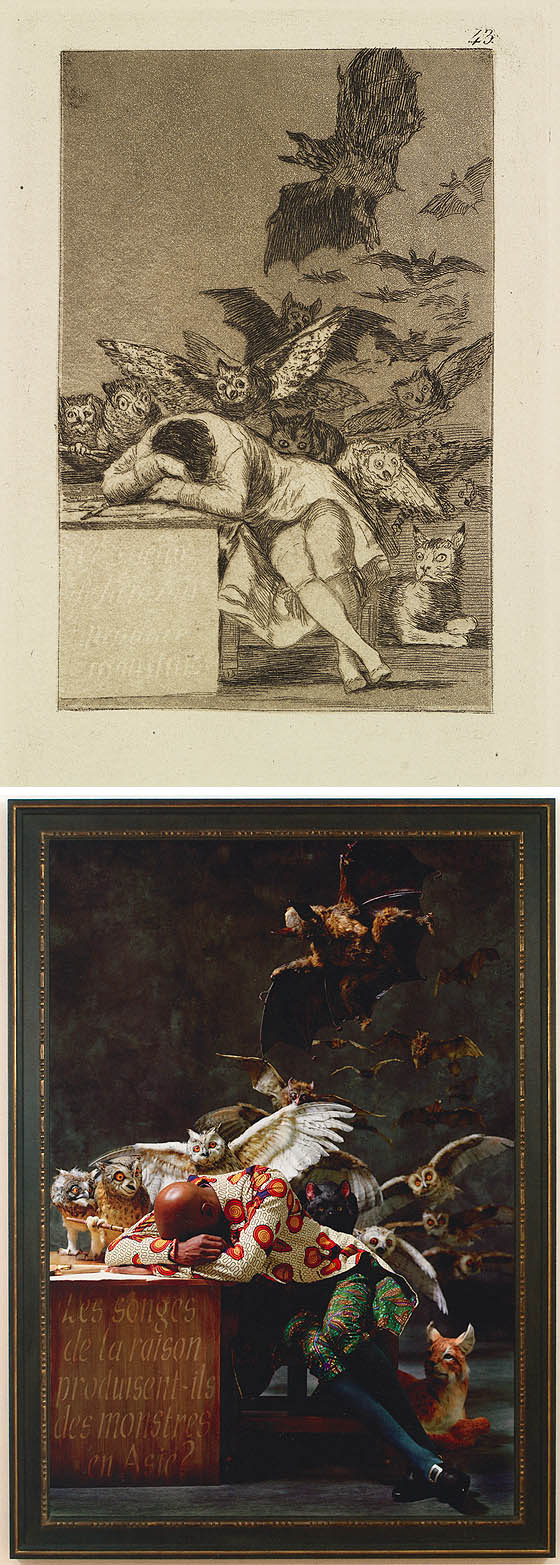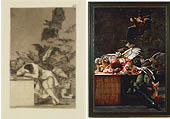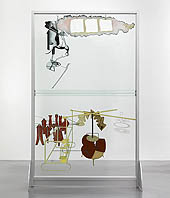
translated and summarized by: Liz Wollner-Grandville,
English summaries June 18 - 30
Staatliche Kunsthalle Karlsruhe
Déjà-vu? The art of replication. From Dürer to YouTube
21.04.2012 – 05.08.2012
By Matthias Kampmann
There's hardly a theme that divides the intelligentsia in a more ongoing fashion than the question of the entity and non-entity of a copy and copying in the age of the internet. One hears about it from film-makers, writers and musicians who are worried about their sinecure. Graphic artists are outnumbered in this distortive battle. How the copy has shaped and enriched our visual culture from the beginning is really exemplified and mirrored in the history of painting, sculptures and graphics.
It's the special merit of a wonderfully structured and prepared exhibition in the Staatliche Kunsthalle Karlsruhe to correct this fashionable, one-side view. Plausible, exciting and based on solid, historical research, the show offers the opportunity of expanding the horizon with a view of the exhilarating heritage of artistic copies with the aid of around 120 works from the late Middle Ages to the present time. "Déjà-vu. The art of replication from Dürer to YouTube”.
The exhibition commences with a photographic work by Claudia Angelmaier. The 2-metre wide tableau, "The Large Piece of Lawn, 2004/2008" shows Albrecht Dürer's iconic-like aquarelle in a very special way. The artist, born 1972, has read into a dozen art books - in which the legendary picture is printed – and has arranged and lighted these in a small public collection in two rows of six double-paged books. Plainly visible differences show the impossibility of substituting the original.
A propos Dürer. The work of the Frankish superstar of the German Renaissance pervades almost the entire exhibition. And not without reason, because he marks the new-age conception of an original notion which implies and reveals the mercantile factors and the emergence of the artist's subject. That was completely different in the Middle Ages. At that time, copies were the guarantor for consistent iconographies and ensured aesthetic orientation. The copy was the norm.
At last a show which doesn't only organize its contents plausibly and clearly in the exhibition rooms but also offers a comprehensive contribution to the, up till now, only partially written art history of copying.
In the later part of the 20th century, the copy mutated to the artistic principle. In the years of Appropriation Art, the conceptual of sharpening the bastion called Genius was invoked and artists developed the dissolution of picture boundaries by devaluation of material factors such as canvas colour or form. Elaine Sturtevant, exemplary protagonist for this mode of appropriation, once said: "It's an art that repeats the seduction of the superfluous and in the process of the replication, dissolves to make way for the most important thing – the thought.
But the story isn't over by a long chalk. Klaus Mosettig's pencil drawings of the action paintings, "Lavender Mist“, by Jackson Pollock, are more than just meticulous emulations. They deflect the gaze to process and time. That laypeople imitate Cindy Sherman on YouTube or Flickr brings the everyday back into the picture following the fascination of the story of the copy.
State Art Gallery Karlsruhe
76133 Karlsruhe, Hans-Thoma-Straße 2-6
Tel: 0721 - 926 33 59
Fax: (0721) 926 67 88
E-mail: info@kunsthalle-karlsruhe.de
www.kunsthalle-karlsruhe.de
Opening hours: Tue-Fri 10.00 - 17.00, Sat, Sun, public holidays 10.00 - 18.00
TBA21 Augarten
Simon Starling and Superflex – Reprotypes, Triangulations and Road Tests
30.05.2012 – 23.09.2012
by Roland Schöny
The string is stretched to breaking point. And that's how far the field is stretched between the meaning of the symbolic and the real. The trails lead back from the present of this genial festival into the gloomy past of the 20th century. And thereby, the visual characters on the level of language and history are brought together. The setting is the Vienna Augarten, where the Thyssen-Bornemisza Art Contemporary is exhibiting in the Ambrosi Atelier that has recently become part of the Austrian Belvedere Gallery. A co-operation which is set between the British Turner Prize winner, Simon Starling, and the Danish artists' collective, Superflex.
The way in which these concepts touch upon each other is almost unbelievable; partly bordering on the absurd. It hardly needs to be emphasized that conventions are circumvented in art, but it does here. Superflex allows two cows to graze on the lawns of the urbane Augarten, whose green spaces are, at most, only used for occasional events. The unusual spectacle of the cattle in the city environment is based on the biographical background of the opportunistic sculptor, Gustinus Ambrosi. After 1934, he collaborated with the Austro-Fascist system before trying it with the National Socialists and becoming a protégé of Albert Speer's. In the end, although Ambrosi had already invested in the animal model, the National Socialists showed no interest in a planned work entitled "Virgin with Cow". Not to be mourned by any means. As an uninteresting and reactionary artist who always knew how to take care of himself, Ambrosi received the aforementioned atelier as a personal museum, studio and homestead following a decision taken by the Austrian Council of Ministers in 1951. At last, this neglected part of the Austrian cultural history was being dealt with. At the same time, it had to do with Modernism, which, as is well known, has two sides. And National Socialism represents the negative and barbaric side.
When Simon Starling mounted part of a shed roof onto a transporter as if it were a reversed spoiler – and which the French draughtsman and designer, Jean Prouvé (died 1981 in Nancy) approx. 1956 designed for the Lycée Blaise Pascal – and drove this vehicle at the highest possible speed over a flying field north of Vienna, we're talking about an endurance test in more than one sense. On one side, this is about a real test from the point of view of a typical approach by Simon Starling. He's particularly interested in the consistency of materials and, in connection with this, in the technical permutations. Therefore, the small transporter with the Prouvé roof piece on its top is exhibited in the Augarten atelier.
And naturally, the search for traces at the level of meaning are pursued. Similar to the way an architectonic part undergoes a test run – which, in reality, is absolutely normal – different dimensions of Modernism are exposed and questioned in the exhibition; under the aspect of the history of design, technique and science. For "D1 - Z1 (22,686,575:1)", for example, Starling reconstructed what is regarded as the first freely programmable computer in the world. It pertains to the Z1 calculator with 172 bytes storage space developed by Konrad Zuse in 1936. There's a 30-second animation sequence in black-and-white, which has been transferred onto conventional 35-mm film and projected by a D1 projector made in Dresden.
The spiral turns further at the moment when one encounters the photographs of a palace which the German architect, Eckart Muthesius, designed for the Indian Maharaja of Indore (in the Federal States of Madhya Pradesh) in the 1930's. In his innovative concepts he unites the contemporary designs and technique of Le Corbusier, Eileen Gray, Marcel Breuer, Lily Reich or Constantin Brancusi.
One can then envision that the hanging lamps - a co-operation project between Simon Starling and Superflex - in all the rooms of the Augarten ateliers hail back to the ideas of the Danish designers, Poul Henningsen, from the year 1924. He conceived similar lights for the Tivoli leisure park in Copenhagen. The special thing about their design is that the lamellae of the lights allow the general light to be spread but however don't let it shine upwards. The reason for this is clear as soon as one realizes when they were created. It embodies shielding the light as protection from air raids.
We see which point we have reached and with what obscenity Mr. Ambrosi assimilates himself. It's inexplicable as to why his tale in this place has never been comprehensively dealt with. Alternatively, it would not have been fitting to have put him too much in the limelight. A much more subtle, fine-branched exhibition has emerged around the notions and concepts of Modernism. Because it pertains to both questions of visual representation and to meanings in historical and socio-political contexts, this project demands time from its visitors; and above all, the readiness to work. The wish is therefore definitely for elaborate, German-language mediation material.
CATALOGUE
Simon Starling / Superflex
Reprotypes, Triangulations and Road Tests
Published by Thyssen-Bornemisza Art Contemporary, 150 pages / English.
Design: Vaguely Contemporary (Sara Hartman, John McCusker, Berlin / New York), with texts by Esther da Costa Meyer, Robin Mackay, Venugopal Maddipati, Mirjam Schaub and Birgit Schneider.
TBA21 Augarten
1020 Wien, Scherzergasse 1A
Tel: +43 1 513 98 56 – 24
E-mail: exhibitions@TBA21.org
www.TBA21.org
Opening hours: Daily 11-19 h, Fri 11-22 h
Lenbachhaus Kunstbau
Marcel Duchamp in Munich 1912
31.3.12 – 15.07.12
by Stephan Maier
No-one takes any notice when you arrive in Munich and get out of the train. But when someone like Marcel Duchamp once amused himself in the Bavarian provincial capital, a large reception is prepared for him and the "negligible" time lag of exactly 100 years arguably lies in the Bavarian way of life and is established in its homely, protracted "we are us" sovereignty.
Focusing on the artist's three-month stay in Munich, the Kunstbau der Städtischen Galerie in the Lenbachhaus is showing, for the first time, two paintings which were created there flanked by numerous indicative sketches and the always-fascinating miniature museum of his "Boxes-in-the-case", and complements Duchamp's transition from painter to reticent thinker and chess player in works that were realised earlier or conceptually fixed.
Besides diverse, rather luckless affairs, Duchamp's self-ordered exile dates back to the brusque rejection of "Act on Descending Stairs, No. 2" by the Paris Salon des Indépendants and the Hardliner Cubist Clique around Albert Gleizes. The interim icons of classical Modernism– never before seen in Germany! - appeared contradictory to the artist's encrusted principles of fragmentation and dissection. "An act never descends the stairs, an act lies ...." such the jury's rationale.
Which was reason enough for Duchamp to leave the city without any explanation and to ensconce himself in the house of his Munich friend, Max Bergmann, the "Cow painter", in June 1912, and afterwards in the Barerstraße 65.
Alone the fact that the "Munich" works – "The transition from Virgin to Bride" and the "Bride" are presented in one space together in a developmentally historical dialogue with the “Act on Descending Stairs, No. 2”, as well as the "Great Glass" (1915-1923) is the true sensation of the wonderfully concentrated exhibition.
In and between both paintings, the disengagement from every Cubist obligation and the shackles and limitations of the panel painting is accomplished. Munich is also the well-considered farewell from painting in instalments.
In Munich, Duchamp developed the first sketches for "The Bride Denuded by her Bachelors, actually (Great Glass)" – without a doubt one of the most masterful mystery plays of the 20th century. And one should simply leave the numerous interpretative attempts at interpretation to one side in front of this terrifying contemporary genre picture of the mechanised battle of the sexes, this cryptic sense and sex machine concept: master work. Not difficult to make out is the further technical development of motives, which are applied quaintly-conventionally in the "Bride".
That the "Great Glass", based as unrealistic high-tech verre églomisé, is based on the esteem of the originally used folk art and in the developed modern art technique for the "Blue Rider" surely has to do with the influences of the Swabian bohemian artists. But how did Duchamp develop these ideas that lead him gently but surely out of the adventurous playground of painting into the unforeseeable space of concept and already in 1913 lead him to "Readymade", a chapter that with good reason remains closed? "My sojourn in Munich was the place of my total freedom", said the artist later.
Naturally he read and commented on Kandinsky's "The Art of Spiritual Harmony", he visited the neighbouring Alte Pinakothek regularly and there discovered Lucas Cranach for himself: that may help to explain the development of his "historical spirit" and his belief in the spiritual quality of the art of every epoch; frequent visits to the technical Eldorado of the Deutsches Museum and the Bavarian Industrial Exhibition, both of which possibly – although not definitely proved - influenced his foible for the anonymized machine aesthetic of art, life and love,
And so the talented self-producer leaves much about his stay and his newly won "Munich freedom" in the dark. However: "Munich had a lot of style during these days", says Duchamp ambiguously and then airs the secret of his, even today difficult to understand, enthusiasm: "I never spoke to a living soul but I had a great time".
Lenbachhaus Kunstbau
80333 Munich, Underground station Königsplatz
Tel: +49-89-23 33 20 00
Fax: +49-89-23 33 20 03/4
E-mail: lenbachhaus@muenchen.de
www.lenbachhaus.de
Opening hours: Tue-Sun 10 - 18 h
Mehr Texte von translated and summarized by: Liz Wollner-Grandville


 Teilen
Teilen




